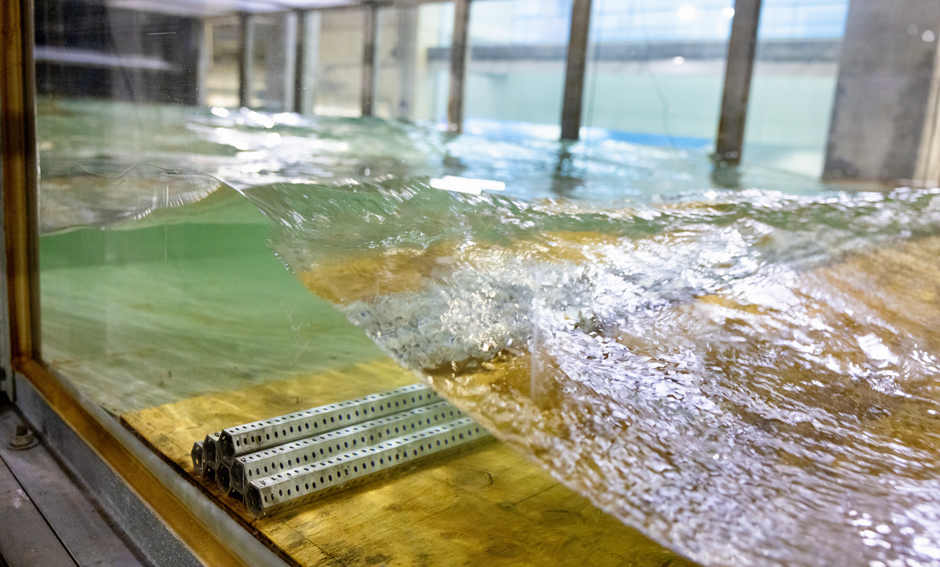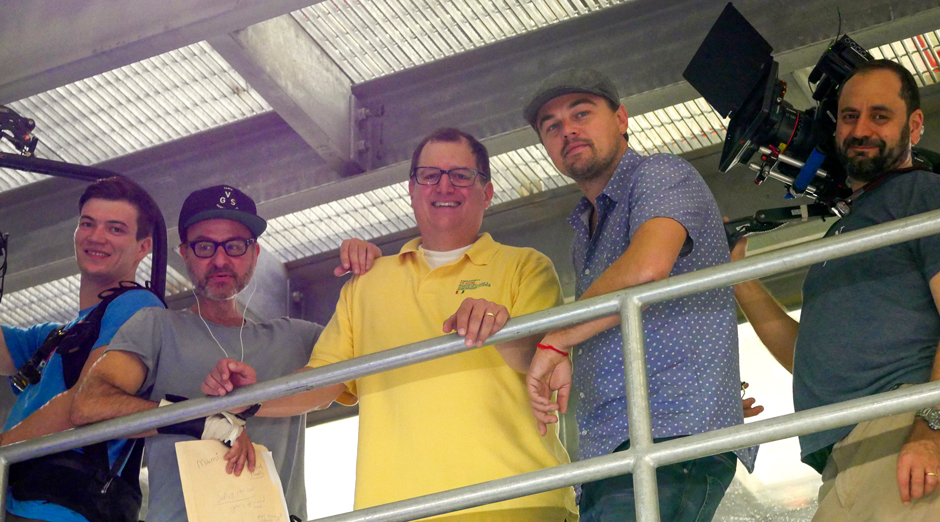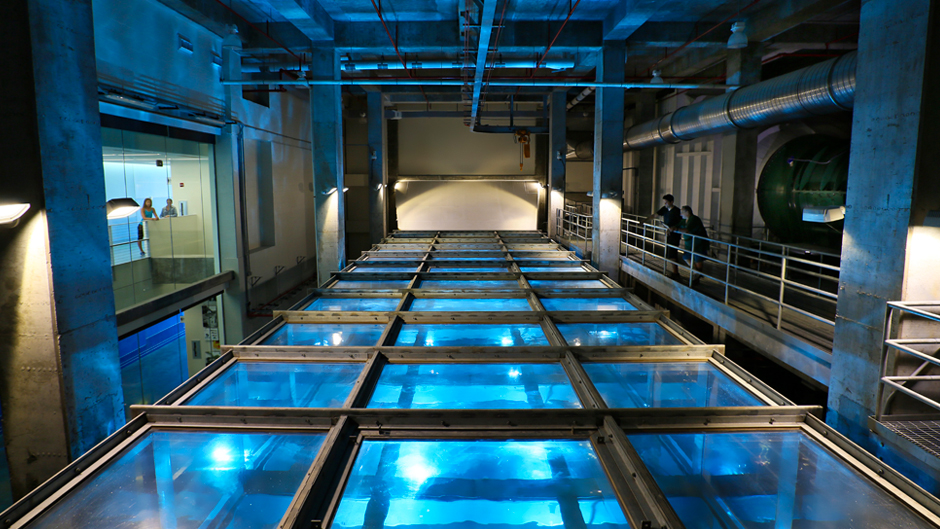It’s the dead of winter, and the only mention of a hurricane revolves around what the upcoming season might bring.
Yet, on an 863-acre barrier island in Miami, Florida, a Category 5 cyclone with 155-mile-per-hour winds rages, creating a menacing storm surge.
No hurricane warning is issued. Streets and roadways remain as dry as a desert, roofs intact, and trees and power poles upright.
The storm would last only a few hours. But over the next few months, more no-name cyclones form, then dissipate, in the same isolated area.
Even during the coldest times of the year, it is still hurricane season at the Alfred C. Glassell Jr. SUrge-STructure-Atmosphere INteraction (SUSTAIN) Laboratory on Virginia Key, where hurricanes created by a 1,400-horsepower turbine engine and 16 wave paddles unleash their fury inside a 75-foot-long acrylic chamber with walls as thick as the hull of an icebreaker.
Located at the University of Miami Rosenstiel School of Marine, Atmospheric, and Earth Science, the tank marks a milestone this year: 10 years old—still just a youngling when it comes to the age of important research facilities.
During its decade-long existence, researchers have put it through its paces, cranking it up full blast to learn more about the complex air-sea interface of rapidly changing winds, waves, and currents that play an integral role in the way tropical cyclones intensify.
“Studying that interface in the natural environment is difficult. So, consequently, we don’t know all that we should about it, and that’s why SUSTAIN has been so important; it’s allowed us to monitor water and wind action in a 3D field of view,” said Brian Haus, a professor of ocean sciences who has directed the wind-wave tank since it became operational in 2014. “Over the past decade, we’ve learned a lot about how sea spray is generated in extreme winds, which is important for understanding hurricane rapid intensification. So, we’ve made tremendous strides in that area.”
Rare facility
There are few wind-wave tanks like it in the world.
“The number of facilities where there’s a controlled airflow over a water basin and in which either fresh or seawater can be used is relatively limited,” Haus explained. “We can generate the highest wind speeds in the world—Category 5 winds over water. And we’re doing that at a pretty large scale—23 meters long, 6 meters wide, and 2 meters high. That’s quite a bit larger than other wind-wave tanks. So, the tank’s size, its ability to generate intense winds, and its acrylic design that allows for incredible sightlines all combine to make it unique.”
Using the Rosenstiel School’s smaller Air-Sea Interaction Saltwater Tank (ASIST) as a guide, Haus and a team of researchers designed SUSTAIN in the late 2000s, hoping the project would be awarded a slice of the $55.5 million that the U.S. Commerce Department’s National Institute of Standards and Technology (NIST) was awarding to universities to support the construction of new scientific research facilities.
“ASIST had all the key elements, so we were able to do a lot of the initial design for SUSTAIN based on that smaller tank,” said Haus, noting that the 49-foot ASIST, which can generate hurricane conditions up to Category 3 intensity, is still used. “We just wanted to build bigger and with greater capabilities.”
SUSTAIN made it to the second round of projects for NIST funding but failed to make the final cut. Then, in an unlikely turn of events, renewed hope for the project came with the 2008 financial crisis. Through the American Recovery and Reinvestment Act, the University received $15 million in 2009 to take SUSTAIN from concept to reality. Funding from the Glassell Family Foundation also supported the construction of the lab.
Varied uses
Today, the tank’s research footprint has expanded beyond simulating and studying the air-sea interface under a hurricane. Researchers have placed scale models of artificial coral reefs inside of it, testing the models’ ability to lessen the impacts of powerful waves and storm surge.

“SUSTAIN has been invaluable to our research on reef restoration and the development of hybrid artificial reefs,” said Diego Lirman, an associate professor of marine biology and ecology and lead investigator for ECoREEF (Engineering Coastal Resilience Through Hybrid Reef Restoration), a University of Miami Laboratory for Integrative Knowledge (U-LINK) project that last year deployed full-scale hybrid reef units 1,000 feet offshore of North Beach Oceanside Park in Miami Beach.
“For the first time, we were able to use scaled reef and coral models to test the role that corals play on wave mitigation when added to artificial structures,” he said. “By deploying coral models onto novel artificial reef modules and testing these together in SUSTAIN, we were able to show that adding corals to artificial reefs increases the reef's wave mitigation potential by up to 15 percent through added friction. This knowledge is valuable not only for the design and deployment of hybrid reefs but also for the restoration of natural reefs.”
Without conducting critical testing in SUSTAIN, it would have proved extremely difficult for professor of ocean sciences Tamay M. Özgökmen and his team to design an effective floating GPS-equipped drifter that helps determine the fate of oil spilled in a marine environment, he admitted.
“We simulated everything from calm waters to breaking waves and turbulent seas, then observed how our drifter performed under those conditions. It was a much easier and time-efficient process than having to go out on a vessel multiple times to test the drifters at sea, where we couldn’t control oceanic conditions,” said Özgökmen, director of the Rosenstiel School’s Consortium for Advanced Research on Transport of Hydrocarbon in the Environment (CARTHE), an initiative created shortly after the Deepwater Horizon explosion to study the oil spill and its impact on the Gulf of Mexico’s delicate ecosystem.
After hundreds of tests in SUSTAIN, thousands of the drifters, which were initially made of plastic but then redesigned with biodegradable materials, were released into the Northern Gulf over a 10-year period, gathering valuable information that has helped researchers learn where oil will end up when future spills occur.
The CARTHE drifter is now patented and in high demand. “People see how effective it is, but what they don’t see are the thousands of hours that went into designing and testing it,” Özgökmen said. “SUSTAIN really made it possible.”
On one occasion, the 38,000-gallon tank even served as a giant aquarium. With Hurricane Irma bearing down on South Florida in 2017, researchers at the University’s Experimental Fish Hatchery needed a place to temporarily house and protect some of the valuable and endangered marine life they study. And ironically, the safest place for them turned out to be the Rosenstiel School’s hurricane simulator. Cobia, hogfish, and endangered Nassau grouper all rode out the storm in the safety of a saltwater-filled SUSTAIN.
And in May of this year, a company tested its floating solar panels in the tank, measuring how they withstood high winds and waves.
Versatile facility
Such varied research projects are indicative of SUSTAIN’s versatility, Haus said. “For researchers from around the world who want to answer certain questions, whether it’s those that deal with the processes of air-sea interaction, or how winds and waves act on structures, or the global carbon cycle, we offer a unique measurement capability that no one else can,” he said.
“It pushes boundaries,” said Landolf Rhode-Barbarigos, associate professor of civil and architectural engineering in the College of Engineering, who has conducted experiments in the tank for a hybrid reef research project in which he is involved. “It allows us to go from an idea, a theory, to analytical modeling and testing, to actually deploying full-scale versions of our research endeavors.”
The ability to conduct studies that are fundamental to addressing sustainability is arguably SUSTAIN’s strongest attribute, according to Antonio Nanni, a professor of civil and architectural engineering in the College of Engineering and one of the initial co-principal investigators for the project. “It’s located in the right place because Miami is ground zero for issues related to hurricanes and sea level rise,” he said. “It’s put us on the map in that regard.”

Leonardo DiCaprio, second from right, with Rosenstiel School scientists Ben Kirtman, center.
Scientists from Australia, France, Germany, and Japan have all traveled to Virginia Key to conduct experiments in the tank. And it has even garnered celebrity status of sorts. Actor Leonardo DiCaprio, NBC Today weather anchor Al Roker, CNN’s Anderson Cooper, and Bill Nye, the Science Guy, have all visited and seen the tank in action.
Funding from the Inflation Reduction Act will help expand SUSTAIN’s capabilities in the coming year, according to Haus.
“It’s gone beyond what I ever imagined,” he said of the tank.

